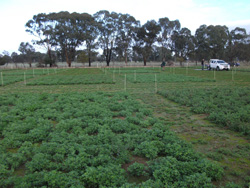Lucerne grazing management is easy

Lucerne is a high-quality forage that is used for hay, grazing and finishing lambs in summer. By responding to summer rain events, it can provide green feed at a time of year when other species have senesced. The inclusion of lucerne in the Hamilton EverGraze experiment reduced supplementary feeding costs by $20/head in the summer of a drought year (2006–07) – which equated to a saving of nearly $300/ha. Despite the obvious benefits, lucerne is only grown on 3.1% of Victoria's grazing land.
One reason for lucerne not being used more widely is the perception that it is hard to manage. It is well understood that lucerne requires a recovery period after grazing or cutting. The length of the recovery period is more important than the level of defoliation. Repeated defoliation with inadequate recovery leads to lower production and reduced stand life (that is, persistence). Popular extension material guidelines usually refer to percentage flowering and/or the length of new shoots from the crown as indicators that the sward is ready for grazing. Both of these require regular checking on the state of your lucerne stand. Another common recommendation is to shut up the lucerne from late summer and allow it to flower, which can take two months or more.
We decided to test some of these guidelines. Percentage flowering is too vague, and we have not been able to get consistent advice on what, say, 10% flowering looks like. We therefore compared two simple calendar-based systems with two systems based on new crown shoots. Our treatments were:
- Short rest – 3 weeks after grazing (SR)
- Long rest – 6 weeks after grazing (LR)
- New shoots from crown have grown to 2cm post-grazing (NS)
- New shoots from crown have grown to 2cm post-grazing, plus a prolonged rest from late summer to flowering near the autumn break (NSF).
We measured persistence, herbage mass and taproot mass in established SARDI Seven lucerne stands at Rutherglen and Hamilton from November 2014 to June 2016.
What did we find?
At Rutherglen the short rest treatment resulted in reduced persistence; at Hamilton it was found that the new shoots and the short rest treatments didn't persist as well.

Key:
- First column (darkest green, left) = SR
- Second column = LR
- Third column = NS
- Fourth column (lightest green, right) = NSF
The long rest treatment produced the highest lucerne dry matter at both sites, and the short rest treatment produced the least at Rutherglen.

Key:
- Left hand column (dark green) = Rutherglen
- Right hand column (light green) = Hamilton
The taproots from the long rest treatment at both sites were at least as healthy (in terms of mass) as those from the other treatments.

Key:
- Black square = SR
- Red circle = LR
- Green triangle = NS
- Blue inverted triangle = NSF
The rest period in the treatments based on plant regrowth varied with the season: in spring it was 14 days for both. In summer the NS treatment was rested for 69 days, and it was 132-142 days in autumn when we allowed that treatment to flower. The maximum rest periods were 69 days (over summer) for the NS treatment, and 132–142 days for the NSF treatment in the autumn, when we allowed the lucerne to go to flower.
Conclusions
Our results indicate that a simple six-week recovery period maintains maximum lucerne productivity and persistence, and is at least as robust as any of the other systems investigated. In terms of practical on-farm application, this approach also removes the subjective assessment of new shoots, which is not always easy to determine.
For further information, contact Meredith Mitchell: meredith.mitchell@agriculture.vic.gov.au